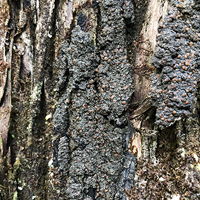White-rimmed Shingle Lichen
Scientific name: Fuscopannaria leucosticta

Photo credit: Samuel Brinkler CC BY-NC 4.0
Status
Endangered
“Endangered” means the species lives in the wild in Ontario but is facing imminent extinction or extirpation.
Date added to the Species at Risk in Ontario List
January 26, 2022
Read the assessment report (PDF)
What it looks like
White-rimmed Shingle Lichen consists of many small, overlapping lobes (like shingles), with a dark olive-grey colour on their upper surface and a noticeable white rim on the edges. Mature colonies produce many brownish coloured discs (fruiting bodies) on their upper surface.
Where it lives
The White-rimmed Shingle Lichen lives almost exclusively on the bark of trees in wet forests, usually occurring on the highest surface of tree trunks that lean away from the vertical position and tends to avoid growing on the southwestern side of tree trunks. This lichen tends to prefer habitat ranging from open swamps with persistent standing water year-round, to dense riparian corridors or transitional habitats near peatlands.
White-rimmed Shingle Lichen occurs primarily in eastern Canada, the southeastern United States, and in Europe and the Asia-Pacific region. It is most commonly found on Red Maple in Nova Scotia, and on Eastern White Cedar in New Brunswick and Ontario.
Where it’s been found in Ontario
The Ontario subpopulation consists of a small cluster of sites from Thunder Bay west to the Quetico region in Rainy River District. It was also found in Lake Superior Provincial Park in 1993.
What threatens it
Logging and wood harvesting of Eastern White Cedar may be a potential threat to this species. Pollution in the form of acid rain may also be a threat, since species in the same group as White-rimmed Shingle Lichen are known to be sensitive to acidification of their habitat.
Action we are taking
Endangered species and their habitat are protected under Ontario’s Endangered Species Act, 2007.
Recovery strategy
A recovery strategy advises the ministry on ways to ensure healthy numbers of the species return to Ontario.
Read the executive summary and the full document (January 25, 2023).
Government response statement
A government response statement outlines the actions the government intends to take or support to help recover the species.
Read the government response statement (October 25, 2023)
What you can do
Report a sighting
Submit your observations of species at risk to the Natural Heritage Information Centre (NHIC), which is Ontario’s conservation data centre. Join the (NHIC) Rare Species of Ontario
project in iNaturalist to make submitting your observations quick and easy.
Volunteer
Volunteer with species at risk programs, such as community science surveys, through your local nature club, a provincial park or other conservation organizations.
Be a good steward
- Individuals, communities and organizations across the province who undertake stewardship or research activities that benefit species at risk and their habitats may be eligible to receive funding through the Species at Risk Stewardship Program (SARSP). The SARSP was created to encourage people to get involved in protecting and recovering species at risk in Ontario through stewardship actions.
- Invasive species seriously threaten many of Ontario’s species at risk. To learn what you can do to help reduce the threat of invasive species, visit:
Report illegal activity
Report any illegal activity related to species at risk to